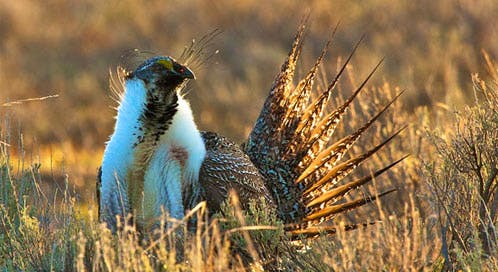When it comes to sage-grouse, everyone agrees that state conservation plans like the one currently being drafted in Montana could be a huge success for the species – if they are done right. But if plans like Montana’s miss the mark, the result could mean another species headed for the ashheap of history.
The sage-grouse is one of the most historically recognizable icons of the American West.
Unfortunately, however, sage-grouse now occupy little more than half of their original range, and current populations are estimated at less than ten percent of historic levels. Populations both westwide and in Montana have plummeted due to increasing development in some of the best remaining sage-grouse habitat. Right now, Montanans have the opportunity to conserve the sage-grouse and the Sagebrush Sea, and potentially avoid the need to list the species. But, half-hearted measures promoted by industry interests will not get the job done. We need to use the best available science to develop conservation plans – science that right now unambiguously points to habitat degradation as today’s leading factor in the decline of this charismatic species.
 But too often science is pushed aside, allowing money and politics to threaten our ability to protect imperiled wildlife. In the case of sage-grouse protection, research has shown time and again that failure to protect nesting areas and associated habitat, increased surface disturbance and high order tramadol online density development in core areas are a recipe for disaster. Montana’s draft sage-grouse plan simply gives away too much critical space to oil and gas drilling, mining and other industries, only exacerbating the problem. By contrast, when industries recognize the impacts of their activities and take the steps necessary to mitigate those impacts, it is a win for both conservation and development.
But too often science is pushed aside, allowing money and politics to threaten our ability to protect imperiled wildlife. In the case of sage-grouse protection, research has shown time and again that failure to protect nesting areas and associated habitat, increased surface disturbance and high order tramadol online density development in core areas are a recipe for disaster. Montana’s draft sage-grouse plan simply gives away too much critical space to oil and gas drilling, mining and other industries, only exacerbating the problem. By contrast, when industries recognize the impacts of their activities and take the steps necessary to mitigate those impacts, it is a win for both conservation and development.
The misguided idea that sage-grouse conservation means economic destruction is perpetuated by the very industry executives whose greed for immediate gain trumps the long-term benefits of cooperation. In reality, we can have both a vibrant energy economy and healthy populations of sage-grouse— that’s why Governor Bullock convened citizens of Montana from all realms of the state’s economies in the hopes of creating a successful conservation strategy.
Our success as individual states and as a nation in protecting sustainable economies goes hand-in-hand with maintaining healthy public lands and protecting our wildlife. Truly working together means less fixation on avoiding listings and greater focus on what is necessary to ensure the recovery of species like the sage-grouse, which will in turn promote those healthy lands for the use of many. Sage-grouse have already contributed more than their share in this compromise; now let’s have a recovery plan in Montana that does right by the birds, by our lands and by our economy.



